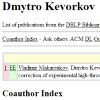| |

François-Joseph Lapointe. How to account for reticulation events in phylogenetic analysis: A review of distance-based methods. In Journal of Classification, Vol. 17:175-184, 2000.
Keywords: abstract network, evaluation, from distances, phylogenetic network, Program Pyramids, Program SplitsTree, Program T REX, pyramid, reconstruction, reticulogram, split network, survey, weak hierarchy.
Note: http://dx.doi.org/10.1007/s003570000016.
|
|
| |
|
| |
|
| |

David A. Morrison. Networks in phylogenetic analysis: new tools for population biology. In IJP, Vol. 35:567-582, 2005.
Keywords: median network, NeighborNet, phylogenetic network, phylogeny, population genetics, Program Network, Program Spectronet, Program SplitsTree, Program T REX, Program TCS, reconstruction, reticulogram, split decomposition, survey.
Note: http://hem.fyristorg.com/acacia/papers/networks.pdf.
|
|
| |
 
David Posada and
Keith A. Crandall. Intraspecific gene genealogies: trees grafting into networks. In TEE, Vol. 16(1):37-45, 2001.
Keywords: likelihood, median network, netting, parsimony, phylogenetic network, phylogeny, Program Arlequin, Program SplitsTree, Program T REX, Program TCS, pyramid, reticulogram, split decomposition, statistical parsimony, survey.
Note: http://darwin.uvigo.es/download/papers/09.networks01.pdf.
|
|
| |
|
| |
   
Galina Glazko,
Vladimir Makarenkov,
Jing Liu and
Arcady Mushegian. Evolutionary history of bacteriophages with double-stranded DNA genomes. In Biology Direct, Vol. 2(36), 2007.
Keywords: explicit network, from sequences, phylogenetic network, phylogeny, Program T REX.
Note: http://dx.doi.org/10.1186/1745-6150-2-36.
Toggle abstract
"Background: Reconstruction of evolutionary history of bacteriophages is a difficult problem because of fast sequence drift and lack of omnipresent genes in phage genomes. Moreover, losses and recombinational exchanges of genes are so pervasive in phages that the plausibility of phylogenetic inference in phage kingdom has been questioned. Results: We compiled the profiles of presence and absence of 803 orthologous genes in 158 completely sequenced phages with double-stranded DNA genomes and used these gene content vectors to infer the evolutionary history of phages. There were 18 well-supported clades, mostly corresponding to accepted genera, but in some cases appearing to define new taxonomic groups. Conflicts between this phylogeny and trees constructed from sequence alignments of phage proteins were exploited to infer 294 specific acts of intergenome gene transfer. Conclusion: A notoriously reticulate evolutionary history of fast-evolving phages can be reconstructed in considerable detail by quantitative comparative genomics. © 2007 Glazko et al; licensee BioMed Central Ltd."
|
|
| |
 
Alix Boc and
Vladimir Makarenkov. Towards an accurate identification of mosaic genes and partial horizontal gene transfers. In NAR, Vol. 39(21):e144, 2011.
Keywords: explicit network, from sequences, lateral gene transfer, phylogenetic network, phylogeny, Program T REX, reconstruction.
Note: http://dx.doi.org/10.1093/nar/gkr735.
Toggle abstract
"Many bacteria and viruses adapt to varying environmental conditions through the acquisition of mosaic genes. A mosaic gene is composed of alternating sequence polymorphisms either belonging to the host original allele or derived from the integrated donor DNA. Often, the integrated sequence contains a selectable genetic marker (e.g. marker allowing for antibiotic resistance). An effective identification of mosaic genes and detection of corresponding partial horizontal gene transfers (HGTs) are among the most important challenges posed by evolutionary biology. We developed a method for detecting partial HGT events and related intragenic recombination giving rise to the formation of mosaic genes. A bootstrap procedure incorporated in our method is used to assess the support of each predicted partial gene transfer. The proposed method can be also applied to confirm or discard complete (i.e. traditional) horizontal gene transfers detected by any HGT inferring method. While working on a full-genome scale, the new method can be used to assess the level of mosaicism in the considered genomes as well as the rates of complete and partial HGT underlying their evolution. © 2011 The Author(s)."
|
|
| |
  
Alix Boc,
Alpha B. Diallo and
Vladimir Makarenkov. T-REX: a web server for inferring, validating and visualizing phylogenetic trees and networks. In NAR, Vol. 40(W1):W573-W579, 2012.
Keywords: from rooted trees, from species tree, lateral gene transfer, phylogenetic network, phylogeny, Program T REX, reconstruction, reticulogram, software.
Note: http://dx.doi.org/10.1093/nar/gks485.
Toggle abstract
"T-REX (Tree and reticulogram REConstruction) is a web server dedicated to the reconstruction of phylogenetic trees, reticulation networks and to the inference of horizontal gene transfer (HGT) events. T-REX includes several popular bioinformatics applications such as MUSCLE, MAFFT, Neighbor Joining, NINJA, BioNJ, PhyML, RAxML, random phylogenetic tree generator and some well-known sequence-to-distance transformation models. It also comprises fast and effective methods for inferring phylogenetic trees from complete and incomplete distance matrices as well as for reconstructing reticulograms and HGT networks, including the detection and validation of complete and partial gene transfers, inference of consensus HGT scenarios and interactive HGT identification, developed by the authors. The included methods allows for validating and visualizing phylogenetic trees and networks which can be built from distance or sequence data. The web server is available at: www.trex.uqam.ca. © 2012 The Author(s)."
|
|
| |
|
|
|
 - forked on GitHub.
- forked on GitHub.


















